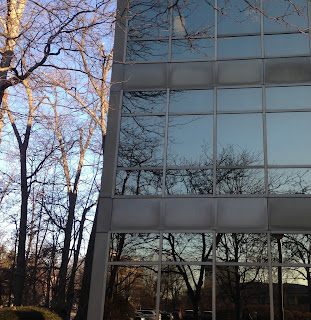If you'd like to make your home bird-friendly, begin by identifying problem windows. Large, plate-glass windows, and windows that reflect vegetation, often have the most strikes. Or, if you know a specific window that's had just one bird collide with it in the past, start with that window: there are probably more birds hitting when you aren't around.
Next, decide how best to break up the reflection. There are many options for this:
1. Decals or other visual cues. These can be placed on the windows to make the windows visible to birds.
1. Decals or other visual cues. These can be placed on the windows to make the windows visible to birds.
- NOTE: one or two decals is not enough! The birds will attempt to fly through or around them.
- Keep in mind the 2 x 4 rule: decals placed in rows (i.e. horizontally) should be spaced 2 inches apart. Decals placed in columns (i.e. vertically) should be spaced 4 inches apart.
- The decals should be at least 1/8 inch in size and should contrast as much as possible with the window.
- Source: www.flap.org
There are several different kinds of decals out there, including ABC BirdTape, WindowDressing, and WindowAlert.
2. Film that is opaque or dotted from the outside, but completely see-through from the inside:
From the outside, the window is opaque...
...and from the inside, the film is hardly noticeable.
Bird/window collisions have been greatly reduced with the use of CollideEscape, as well as similar films like Feather Friendly.
3. Screens and cords: screens cushion the birds when they hit, whereas cords actively break up the reflection of the glass, but both are effective at preventing strikes.
BirdScreen and Acopian BirdSavers are inexpensive and quickly produce results.
- Move your bird feeders and birdbaths to within 3 feet or less of any nearby windows, so the birds will not be able to get up enough speed to hurt themselves.
- Install external awnings or sun shades to block the reflection of the sunlight.
- If you have interior blinds or slatted curtains, leave the slats only half-open.
- Add screens to the outside of the glass (if installing new windows, consider double-hung windows, which come with exterior screens pre-installed).
Additional Resources and Information
- FLAP.org
- Why Birds Hit Windows & How You Can Help Prevent It (via All About Birds)
- 15 products that prevent bird strikes
- See also: birdsmartglass.org, CollidEscape
- American Bird Conservancy: Bird Friendly Building Guidelines (pdf)
- More from ABC: Glass Collisions and Bird Tape (via collisions.abcbirds.org)
For an extensive list of publications (warning: pdfs!) pertaining to the overall impact (conservation, population, etc) of bird collisions:
Acopian Center for Ornithology's bird-window collision links
Resources for Southeast Michigan residents:
- Bird Center of Washtenaw County
- Washtenaw County Wildlife Rescue (24/7!)
- Washtenaw Audubon
- Detroit Audubon: Project Safe Passage
- Michigan Dark Skies
- If you'd like to see an almost-local window with CollidEscape in action, check out the visitor center at Point Pelee National Park in Ontario.
(Updated 23 Jan 2019)






No comments:
Post a Comment